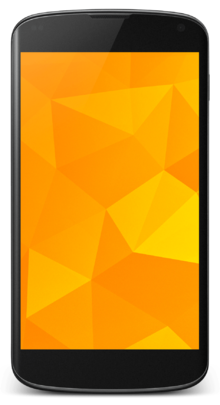 | |
 Nexus 4 | |
| Developer | Google, LG Electronics |
|---|---|
| Manufacturer | LG Electronics |
| Type | Smartphone |
| Series | Google Nexus |
| First released | November 13, 2012 |
| Availability by region | November 13, 2012 (Google Play) |
| Discontinued | November 1, 2013[1] |
| Units sold | One million, as of February 2013[update][2] 3 million as of 2Q 2013[3][4][5] |
| Predecessor | Galaxy Nexus |
| Successor | Nexus 5 |
| Related | Optimus G |
| Compatible networks | GSM/EDGE/GPRS (850, 900, 1800, 1900 MHz)[6] 3G UMTS/HSPA+/DC-HSPA+ (850, 900, 1700, 1900, 2100 MHz) |
| Form factor | Slate |
| Dimensions | 133.9 mm (5.27 in) H 68.7 mm (2.70 in) W 9.1 mm (0.36 in) D[6] |
| Weight | 139 g (4.9 oz)[6] |
| Operating system | Original: Android 4.2 "Jelly Bean" Last: Android 5.1.1 "Lollipop"[7] |
| System-on-chip | Qualcomm Snapdragon S4 Pro APQ8064 |
| CPU | 1.5 GHz quad-core Krait |
| GPU | Adreno 320 |
| Memory | 2 GB of LPDDR2 RAM, clocked at 533 MHz |
| Storage | 8 GB or 16 GB |
| Battery | |
| Rear camera | 8 MP back-side illuminated sensor with LED flash 1080p video recording @ 30 fps |
| Front camera | 1.3 MP 720p video recording @ 30 fps |
| Display | 4.7 in (120 mm) diagonal TrueHD IPS with Corning Gorilla Glass 2 1280 × 768 px (318 ppi) |
| Connectivity | 3.5 mm TRRS GPS |
| Data inputs | Multi-touch, capacitive touchscreen, microphone, proximity sensor, Gyroscope, compass, barometer, Accelerometer, ambient light sensor[11] |
| Codename | Mako |
| SAR | Head: 0.546 W/kg (1 g) Body: 1.27 W/kg (1 g) Hotspot: 1.27 W/kg (1 g)[12] |
The Nexus 4 (codenamed Mako[13]) is an Android smartphone co-developed by Google and LG Electronics. It is the fourth smartphone in the Google Nexus product family, unveiled on October 29, 2012, and released on November 13, 2012, and succeeded the Samsung-manufactured Galaxy Nexus. As with other Nexus devices, the Nexus 4 was sold unlocked through Google Play, but was also retailed by wireless carriers.
Compared to the Galaxy Nexus, the Nexus 4 was distinguished from its predecessor by a quad-core Snapdragon S4 Pro processor, an 8 megapixel rear camera and 1.3 megapixel front camera which use the Sony BSI sensor, Qi wireless charging, and the introduction of Android 4.2 Jelly Bean, an update to the operating system which introduced 360-degree spherical photo stitching called "Photo Sphere", a quick settings menu, widgets on the lock screen, gesture typing, and an updated version of Google Now. The Nexus 4 has similar hardware to the Optimus G, the latter also produced by LG.
The Nexus 4 was met with generally positive reviews from critics, who praised the quality and performance of the Nexus 4's hardware. It was also the first Google Nexus device to be released at a relatively lower outright price in comparison to other high-end/flagship smartphones, leading to unexpected high demand and supply shortages. However, the device was criticized for its lack of LTE support, and its lack of a user-removable battery which its predecessor, the Galaxy Nexus, included. It was succeeded by the Nexus 5.
- ^ H., Victor (November 2013). "Nexus 4 is no longer sold on Google Play". Phone Arena. Archived from the original on December 26, 2018. Retrieved October 15, 2014.
- ^ Lomas, Natasha (February 8, 2013). "Nexus 4 Owners Estimate One Million Handsets Have Shipped Since November 2012 Launch". TechCrunch. AOL. Archived from the original on March 8, 2013. Retrieved March 6, 2013.
- ^ Bielinis, Stasys (May 13, 2013). "LG may already be testing Nexus 5 prototype after all sold 3 million Nexus 4s to date". UnwiredView. Archived from the original on September 11, 2013. Retrieved September 6, 2013.
- ^ Stasys (October 4, 2017). "sold 3 million Nexus 4s by mid-2013". carphonewarehouse. Archived from the original on September 21, 2020. Retrieved April 3, 2020.
- ^ Stasys (February 17, 2015). "sold 3 million Nexus 4 handsets by the middle of 2013". androidauthority. Archived from the original on April 1, 2020. Retrieved April 3, 2020.
- ^ a b c d "Nexus 4 tech specs". Archived from the original on December 26, 2018. Retrieved February 9, 2015.
- ^ "Factory Images for Nexus Devices". Archived from the original on December 26, 2018. Retrieved April 15, 2015.
- ^ "Experiences Acceleration of MyDP Standard Adoption in Mobile Devices". VESA. November 9, 2012. Archived from the original on December 26, 2018. Retrieved November 13, 2012.
- ^ "LG Nexus 4 E960". GSM Arena. Archived from the original on December 26, 2018. Retrieved January 30, 2013.
- ^ Klug, Brian (November 13, 2012). "Google Nexus 4 Review - Google's new Flagship". Anandtech. Archived from the original on December 26, 2018. Retrieved January 26, 2013.
- ^ "Google Nexus 4. Speed and power to spare". Archived from the original on February 15, 2020. Retrieved February 20, 2020.
- ^ "OET Exhibits List for FCC ID ZNFE960". fcc.gov. Archived from the original on February 26, 2014. Retrieved January 3, 2014.
- ^ "LG Nexus 4 specs - Engadget". Engadget. Archived from the original on October 13, 2017. Retrieved October 15, 2014.